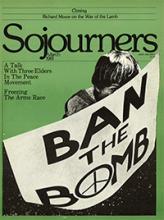During the congressional debate over the SALT II treaty, Sojourners advocated a nuclear moratorium. The Strategic Arms Limitation Treaty did not, we felt, live up to its name. Rather than halting the arms race and reversing its deadly momentum, the treaty would have actually allowed the United States and the Soviet Union to increase their nuclear arsenals, both in quantity and in quality. The proposal for a nuclear moratorium provided a third way between the unattractive alternatives of an inadequate treaty or no treaty at all.
A nuclear arms moratorium simply means a halt or a freeze in the arms race. All further testing, production, and deployment of new and additional nuclear weapons and weapon systems would be immediately stopped. For the first time, the continual escalation and expansion of nuclear weaponry would come to an end. Obviously, this would be only the first step toward actually reversing the arms race and eventually abolishing the threat of nuclear war altogether. However, as a necessary beginning, we felt a nuclear moratorium would be decisively important. To turn around and proceed in another direction, one must first stop going in the direction in which one is already headed.
The moratorium proposal was never debated in the Senate because the SALT II treaty never came to the Senate floor. The Russian invasion of Afghanistan, the fueling of old Cold War fervor by the political Right, and the hesitancy of an insecure president seeking re-election all combined to kill SALT II.
However, the idea of a nuclear moratorium endured and has now begun to spread. Randy Kehler reports in this issue of Sojourners on how a moratorium referendum was passed by a large margin in western Massachusetts, despite the Reagan landslide. Also, Danny Collum and Mernie King describe what a nuclear arms moratorium is and what it could do.
Read the Full Article

